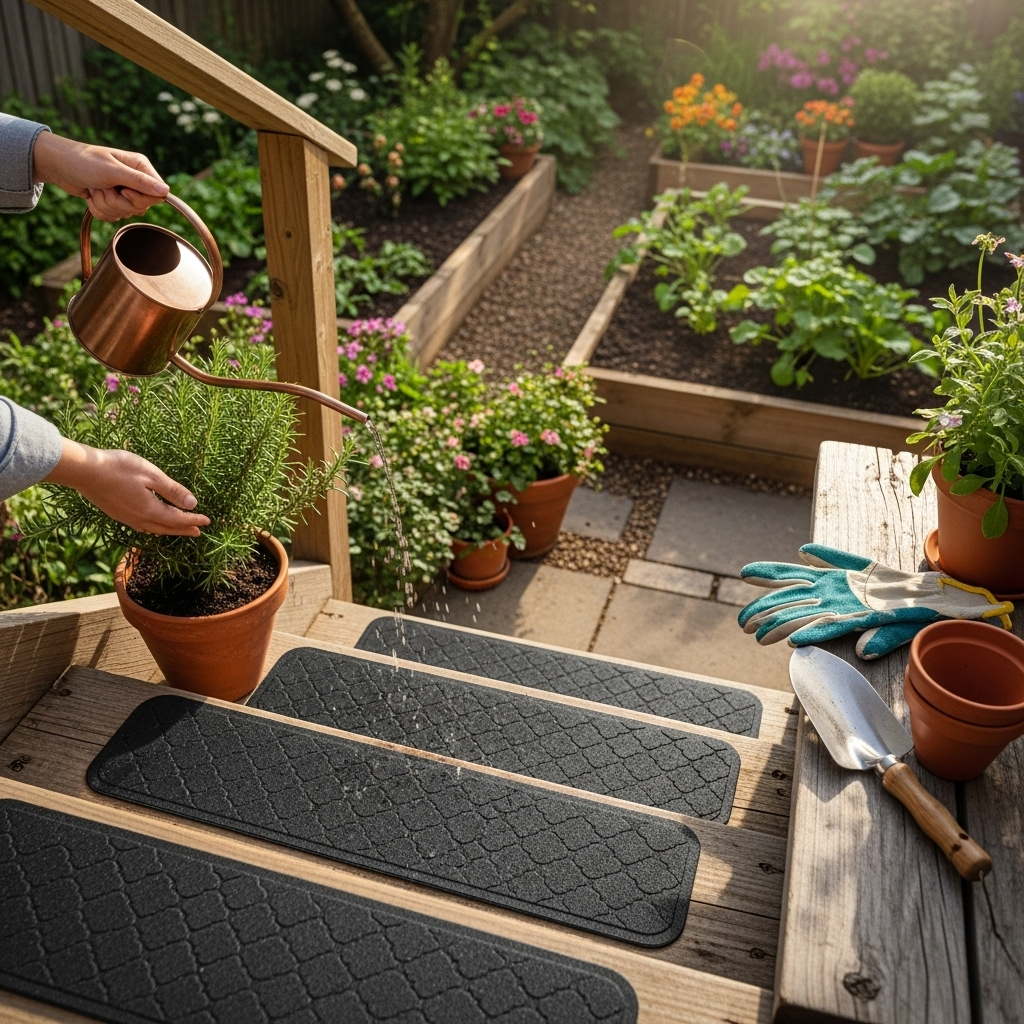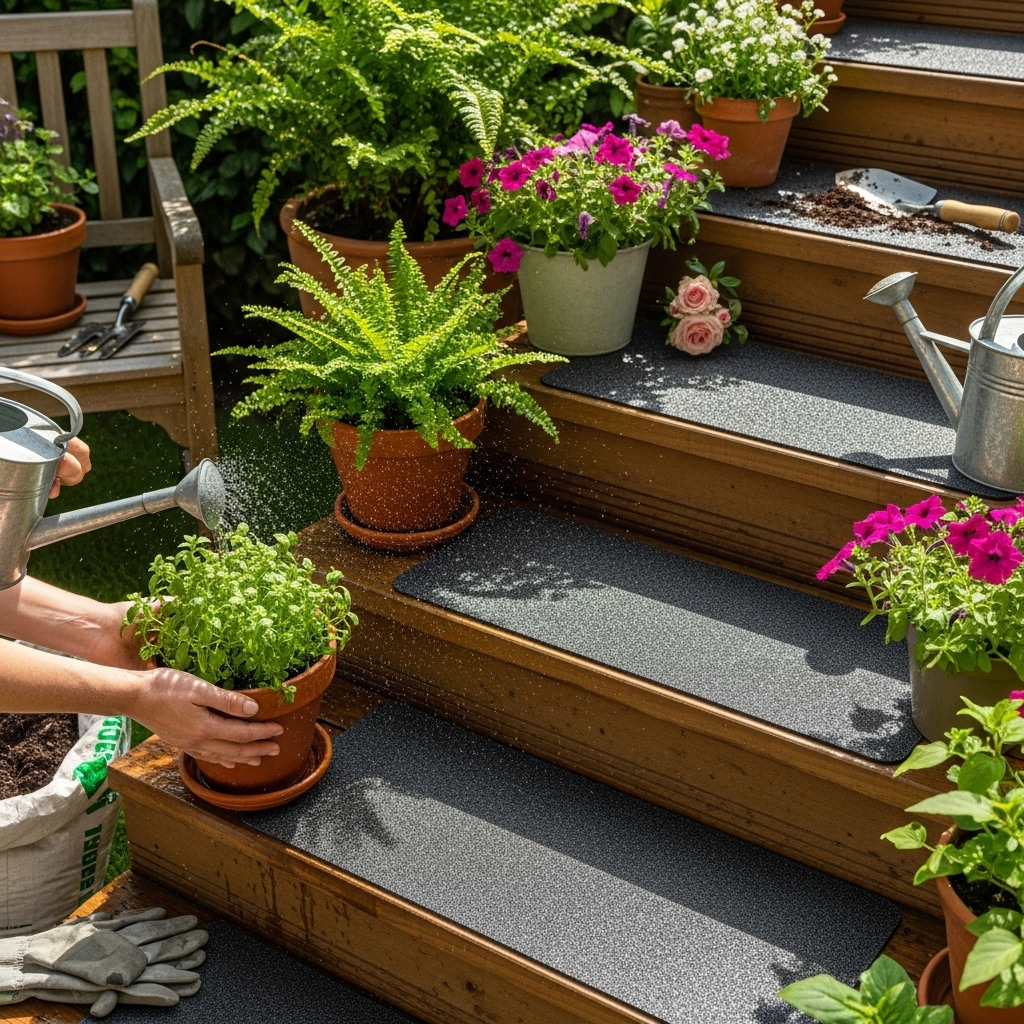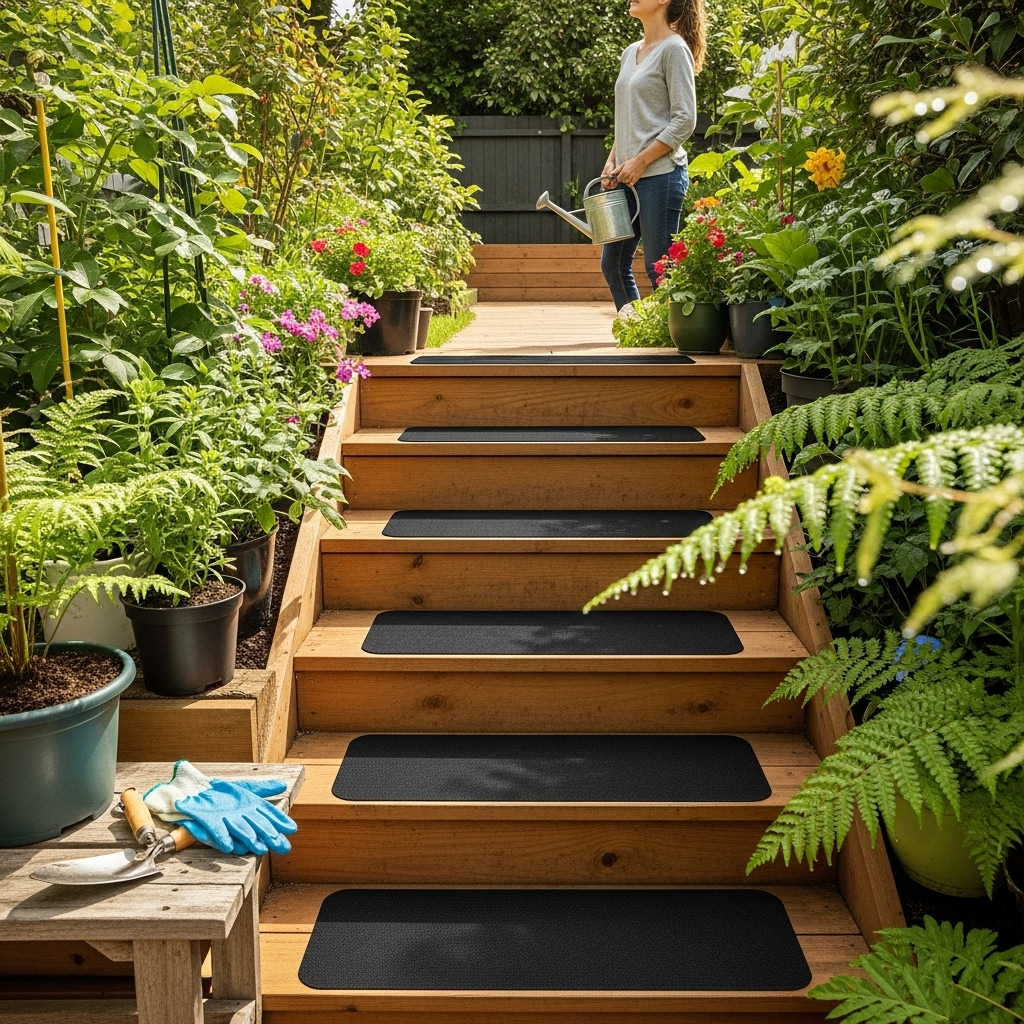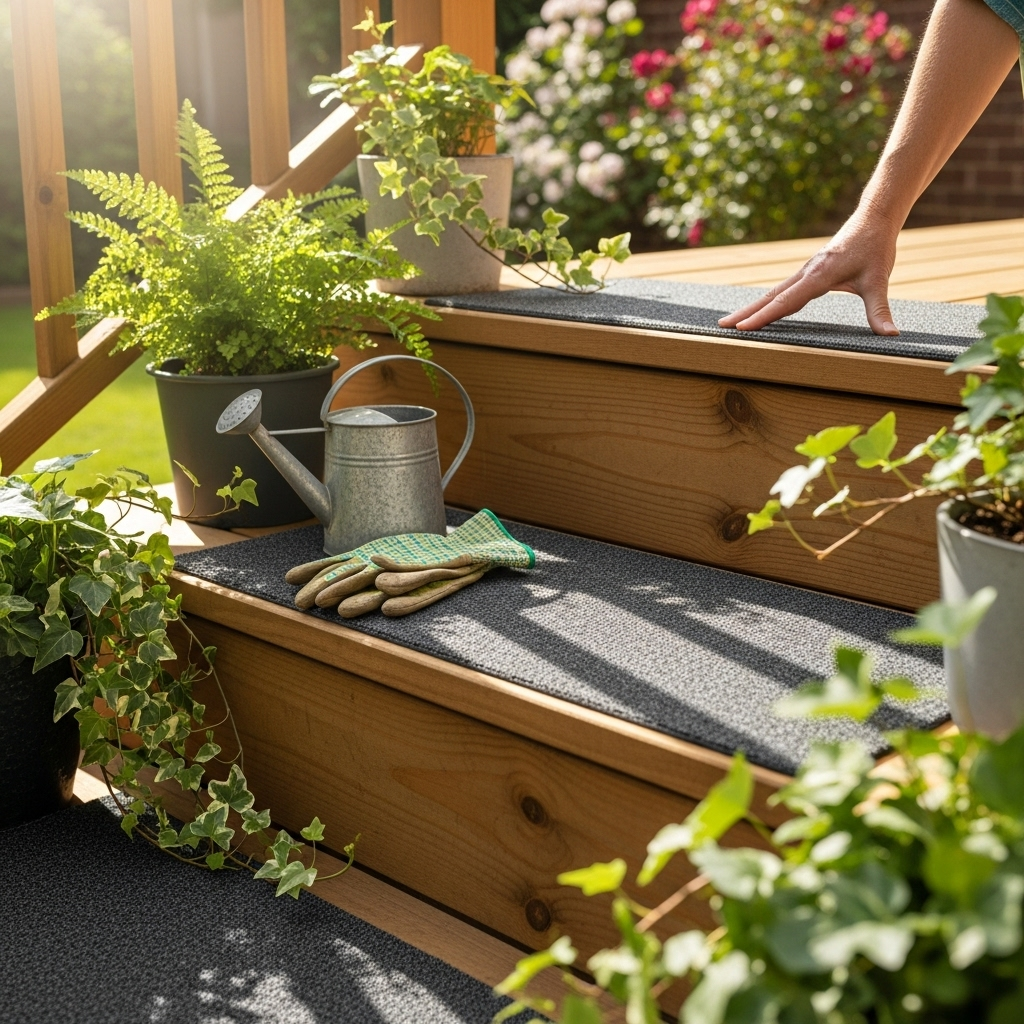Quick Summary
Installing outdoor stair treads is essential for preventing slips and falls, especially in wet or icy conditions. These treads provide crucial grip, enhancing safety for everyone using your outdoor stairs. Choosing the right materials and proper installation ensures long-term security and peace of mind.
Stair treads are like the sturdy shoes our outdoor steps wear! They’re designed to give us a better grip, making our garden paths and porch stairs much safer. Nobody wants to worry about a slippery step, especially when it’s raining, snowing, or just after a dew. That’s where outdoor stair treads come in – they’re simple additions that make a huge difference in preventing tumbles. If your outdoor steps feel a bit slick, or you have family and friends who might need a little extra traction, then it’s time to look into some trusty stair treads. We’ll walk through why they’re so important and how easy it can be to make your stairs safer and more welcoming for everyone.
Why Outdoor Stair Treads Are A Must-Have
Outdoor stairs, whether they lead to your front door, a garden patio, or a deck, are exposed to the elements all year round. This means constant contact with rain, snow, ice, fallen leaves, and even moss and algae growth. All these can make wooden or concrete surfaces incredibly slippery. Sadly, falls on outdoor stairs are a common cause of injuries, ranging from minor scrapes to serious fractures.
Implementing safety measures like outdoor stair treads is a proactive step towards preventing these accidents. They are not just about compliance; they are about creating a welcoming and secure environment for your home. Think of them as adding a layer of confidence for everyone who uses your steps – from children to the elderly.
Beyond safety, stair treads can also enhance the appearance of your outdoor stairs. Many options are available that can complement your home’s aesthetic, adding a touch of polish and character. Let’s explore the key benefits:
- Enhanced Traction: This is the primary benefit. Treads provide a textured surface that significantly reduces the risk of slipping.
- Fall Prevention: By offering better grip, they minimize the chance of accidental slips and falls, protecting you and your loved ones.
- Durability: Many stair tread materials are chosen for their ability to withstand outdoor conditions, prolonging the life of your stairs.
- Aesthetic Appeal: Aesthetically pleasing treads can upgrade the look of your existing stairs.
- Visibility: Some treads are designed with contrasting colors or reflective elements, improving visibility, especially in low-light conditions.
Types of Outdoor Stair Treads

When you start looking for stair treads for outdoors, you’ll find a variety of materials and designs. Each has its own pros and cons, making some better suited for specific environments or preferences. Understanding these options will help you choose the best fit for your needs.
1. Rubber Stair Treads
Rubber treads are a popular choice because they are flexible, durable, and provide excellent grip, even when wet. They are often made from recycled rubber, making them an eco-friendly option too.
- Pros: Great traction, weather-resistant, relatively inexpensive, easy to install, available in various designs and colors, good for absorbing impact.
- Cons: Can wear down over time in very high-traffic areas, some might find the look less “premium” than other materials.
These are ideal for areas where water tends to pool or where ice is a frequent concern. They offer a soft, forgiving surface underfoot.
2. Metal Stair Treads (Aluminum or Steel)
Metal treads, often made from aluminum or galvanized steel, are known for their extreme durability and strength. They usually have perforated or ribbed surfaces to provide grip.
- Pros: Extremely durable, long-lasting, robust, resistant to rust and corrosion (especially galvanized or treated steel/aluminum), good for heavy-duty applications.
- Cons: Can be more expensive, installation might require more specialized tools, can get hot in direct sunlight, metal can be slippery when icy if not designed with aggressive grip patterns.
These are excellent for commercial settings or very high-traffic residential areas where longevity is paramount. They can also add a modern, industrial look to your home.
3. Carpet or Composite Stair Treads
Outdoor carpet treads are made from durable, weather-resistant synthetic fibers designed to withstand the elements. Composite treads blend wood fibers with plastic resins, offering the look of wood with enhanced durability and low maintenance.
- Pros (Carpet): Soft underfoot, good grip, can be quite attractive, provides some cushioning.
- Cons (Carpet): Can absorb moisture and take longer to dry, prone to mildew if not properly maintained, may fade over time.
- Pros (Composite): Very low maintenance, resistant to rot and insects, consistent appearance, often made from recycled materials.
- Cons (Composite): Can be more expensive than rubber or basic wood, may expand/contract with temperature changes, can be slippery when wet if the texture isn’t aggressive enough.
Outdoor carpet treads are best for covered porches or areas that don’t experience excessive moisture. Composite treads are a great low-maintenance alternative to wood but ensure they have a textured surface for safety.
4. Wood or Timber Stair Treads
While your stairs might already be made of wood, specific wood stair treads can be added for extra grip or to repair worn surfaces. Pressure-treated lumber or naturally rot-resistant woods like cedar or redwood are common choices.
- Pros: Natural look, can match existing wooden structures, relatively easy to work with for DIYers, can be stained or sealed to match decor.
- Cons: Requires regular maintenance (sealing, staining) to prevent rot and wear, can become slippery when wet or icy, can warp or crack over time if not maintained.
If you choose wood, consider adding anti-slip strips or coatings to enhance their safety features.
5. Anti-Slip Coatings or Paints
These are not treads in the traditional sense but are applied directly to the stair surface. They contain gritty particles that make the surface much less slippery.
A great resource for understanding different surface treatments and their effectiveness is the Building Science Corporation, which discusses various material properties relevant to outdoor applications.
- Pros: Very cost-effective, easy to apply, can cover the entire stair surface for consistent grip, available in various colors.
- Cons: Durability can vary greatly, may need reapplication every few years, can affect the aesthetic significantly, may not provide as much physical grip as a raised tread.
This is a good option for a temporary fix or for those on a tight budget. For more robust solutions, consider treads designed for specific material types.
Choosing the Right Material and Style
Selecting the best stair treads depends on several factors. Think about your budget, the climate you live in, the amount of foot traffic your stairs receive, and the overall look you want to achieve.
Consider Your Climate
- Wet Climates: Rubber or metal treads with aggressive grip patterns are excellent. They dry relatively quickly and offer
consistent traction. Ensure good drainage to prevent water from pooling on or under the treads. - Icy Climates: Metal treads are often preferred due to their durability and ability to withstand harsh conditions. Some composite materials also perform well. For any material, consider adding a non-slip coating or grit.
- Sunny Climates: Darker materials like rubber or dark composites can get very hot underfoot. Lighter colors or materials that don’t absorb as much heat might be preferable.
Foot Traffic and Durability
- High Traffic: Opt for durable materials like metal or high-quality rubber. These will withstand wear and tear better over time.
- Low Traffic: You might have more flexibility with materials like carpet or wood, but still prioritize safety surfaces.
Aesthetics
Stair treads can either blend in or make a statement. Choose a color and material that complements your home’s exterior. For a natural look, wood or wood-look composites are good. For a modern feel, sleek metal or dark rubber treads work well.
Ease of Installation
Many rubber and carpet treads come with adhesive backing or are designed for simple screw-down installation, making them great DIY choices. Metal or custom wood treads might require more specialized tools and skills.
Here’s a quick comparison table to help you decide:
| Tread Material | Best For | Durability | Cost (Approx.) | Installation Ease |
|---|---|---|---|---|
| Rubber | Wet/Icy conditions, general use | Good | $ – $$ | Easy |
| Metal (Aluminum/Steel) | High traffic, extreme durability needs | Excellent | $$ – $$$ | Moderate |
| Carpet (Outdoor) | Covered areas, moderate traffic | Fair | $ – $$ | Easy |
| Composite | Low-maintenance, wood-look | Good | $$ – $$$ | Moderate |
| Wood/Timber | Natural aesthetic, DIY friendly | Fair (with maintenance) | $ – $$ | Easy to Moderate |
| Anti-Slip Coatings | Budget-friendly, quick fix | Fair to Good | $ | Very Easy |
How to Install Outdoor Stair Treads: A Step-by-Step Guide

Installing outdoor stair treads is often a straightforward DIY project. The exact method will vary slightly depending on the type of tread you choose, but the general process is quite similar. We’ll cover a common method that works for many adhesive-backed or screw-down treads.
Tools and Materials You’ll Need:
- Your chosen stair treads
- Measuring tape
- Pencil or marker
- Utility knife (if you need to cut treads)
- Stiff-bristled brush or broom
- Cleaning solution (mild soap and water, or a degreaser if necessary)
- Clean rags or towels
- Drill (if using screw-down treads)
- Appropriate screws or fasteners (often included with treads or recommended by manufacturer)
- Adhesive remover or primer (if using adhesive treads and need extra tack or to ensure clean removal later)
- Safety glasses and gloves
Step 1: Clean Your Stairs Thoroughly
This is arguably the most important step for ensuring a good bond, especially for adhesive treads. Any dirt, dust, oil, or loose debris will prevent the tread from sticking properly.
- Brush away any loose dirt or debris.
- Wash the stairs with a mild soap and water solution. Rinse thoroughly.
- For stubborn grime or mildew, you might need a stronger cleaner. Always test in an inconspicuous area first.
- Ensure the stairs are completely dry before proceeding. This may take several hours or even overnight, depending on the weather.
Step 2: Measure and Plan
Accurate measurements ensure your treads fit perfectly and provide consistent coverage.
- Measure the width and depth of each stair tread.
- If your treads are slightly larger than the stair, decide if you want them to overhang slightly or be flush with the edges. Most commonly, they are installed to cover the primary walking surface, leaving a small border.
- If you need to cut treads to size, measure carefully and mark your cutting lines. It’s often best to lay out a tread on the stair to get the most accurate fit, especially if stairs are not perfectly uniform.
A helpful tip from experienced builders is to check your steps for levelness and straightness. Uneven stairs can make tread installation tricky, but carefully planned cuts and placement can overcome minor imperfections.
Step 3: Cut Treads (If Necessary)
If your treads are not the perfect size, you’ll need to cut them. Always wear safety glasses when cutting.
- For rubber or carpet treads, a sharp utility knife usually works well. You might need to score and cut multiple times.
- For composite or wood treads, you might need a saw, such as a circular saw or jigsaw. Follow the manufacturer’s recommendations for cutting.
- Cut slowly and carefully to ensure clean, straight edges.
- Test the fit of any cut treads on the stairs before proceeding to adhere them.
Step 4: Apply the Treads
This is where the magic happens!
For Adhesive-Backed Treads:
- Peel back a small section of the protective backing from one end of the tread.
- Carefully align the tread with the front edge of the stair.
- Once positioned, press down firmly on the exposed adhesive strip.
- Slowly peel off the rest of the backing as you press the tread down, ensuring it lies flat and without wrinkles or air bubbles.
- Work from the center outwards to push out any trapped air.
- Apply firm, even pressure across the entire surface of the tread. You can use your hands, feet, or a rolling pin-like tool.
For Screw-Down Treads:
- Position the tread correctly on the stair.
- Mark pilot hole locations through the tread’s pre-drilled holes (or mark where you want to place them).
- Drill pilot holes into the stair material. Ensure the pilot holes are slightly smaller than the screw diameter.
- Align the tread over the pilot holes.
- Drive the screws through the tread and into the stair. Do not overtighten, as this can strip the wood or damage the tread.
Step 5: Secure and Inspect
Once all treads are in place, give them a final check.
- Walk on each tread to ensure it’s firmly adhered or screwed down.
- Check the edges to make sure they are laying flat against the stair.
- For adhesive treads, some manufacturers recommend waiting 24-48 hours before allowing heavy traffic or getting them wet to allow the adhesive to fully cure.
Maintenance for Longevity
Keeping your outdoor stair treads in good condition will ensure they provide safety and look great for years to come.
- Regular Cleaning: Sweep or brush off leaves, dirt, and debris regularly. This prevents them from becoming embedded in the tread material and also keeps them from becoming slippery when wet.
- Washing: Periodically wash treads with mild soap and water. For stubborn stains or mildew, you might use a slightly stronger cleaner, but always follow manufacturer recommendations and rinse thoroughly.
- Inspection: Check treads regularly for signs of wear, lifting edges, or damage. Address any issues promptly to maintain their effectiveness and prevent tripping hazards.
- Seasonal Care: In winter, use a plastic shovel to clear snow, as metal shovels can damage some tread materials. Avoid using harsh de-icing chemicals that could degrade the tread.
Proper maintenance not only extends the life of your stair treads but also ensures they continue to provide the essential safety they were installed for.
Safety First: Beyond the Treads

While stair treads are a fantastic safety feature, they are part of a larger picture of outdoor stair safety. Here are a few more tips to keep your steps secure:
- Good Lighting: Ensure your outdoor stairs are well-lit, especially at night. Motion-sensor lights can be a great energy-efficient option.
- Handrails: Sturdy, well-maintained handrails are crucial for providing support and stability. Make sure they are securely attached and extend far enough on both ends of the stairs. The National Library of Medicine provides extensive information on fall prevention, highlighting the importance of features like handrails.
- Clear Obstructions: Keep the area around the stairs clear of clutter, plants that might obscure the steps, or toys that could cause someone to trip.
- Address Structural Issues: If your stairs are wobbly, have loose boards, or show signs of rot, address these structural problems before even thinking about treads.
By combining stair treads with these other safety measures, you create a much more secure and accessible outdoor environment.
Frequently Asked Questions About Outdoor Stair Treads
Q1: How do I know if I need outdoor stair treads?
You should consider outdoor stair treads if your steps are made of materials that become slippery when wet or icy, such as wood, concrete, or metal. If you’ve ever slipped or nearly slipped, or if you have elderly individuals or young children using the stairs frequently, treads are a wise investment.
Q2: Are outdoor stair treads difficult to install?
Generally, no. Many rubber and carpet treads come with strong adhesive backing and can be installed by most DIYers in under an hour with minimal tools. Screw-down treads might require a drill and screws, but the process is still quite manageable for beginners.
Q3: How long do outdoor stair treads last?
The lifespan of outdoor stair treads varies greatly depending on the material, quality, climate, and amount of foot traffic. High-quality rubber or metal treads can last several years, while carpet or less robust materials might need replacement sooner, perhaps every 1-3 years, especially in harsh weather conditions.
Q4: Can I paint my stairs with anti-slip paint instead of using treads?
Yes, anti-slip paint is an alternative. It’s often more budget-friendly and provides a consistent grip across the entire stair surface. However, treads often offer superior traction and can be more durable over time, especially heavy-duty rubber or metal options.
Q5: How do I clean outdoor stair treads?
Most outdoor stair treads can be cleaned with a stiff brush, mild soap, and water. For tougher stains or mildew, slightly stronger outdoor cleaners may be used, but it’s crucial to check the manufacturer’s recommendations to avoid damaging the material. Always rinse thoroughly.
Q6: Will outdoor stair treads get damaged by snow and ice?
Most outdoor stair treads are designed to withstand various weather conditions, including snow and ice. However, using a plastic shovel for snow removal is recommended, and harsh de-icing chemicals can degrade some materials. Metal treads are generally very robust, while rubber and composite materials also hold up well when properly maintained.
Q7: Where is the best place to buy outdoor stair treads?
You can find outdoor stair treads at most home improvement stores, hardware stores, and online retailers. Brands like MatsInc, StarGrip, and various generic options are widely available, offering a range of materials and price points.
Conclusion

Investing in outdoor stair treads is a simple yet incredibly effective way to boost the safety and usability of your home’s exterior steps. By understanding the different material options—from resilient rubber and durable metal to low-maintenance composites and natural wood—you can choose the perfect fit for your climate, your budget, and your home’s style. The installation process is typically straightforward, especially for adhesive-backed types, empowering you to tackle this project yourself and enjoy immediate peace of mind.
Remember, safety is paramount, and outdoor stair treads are a key component. Combined with good lighting and sturdy handrails, they create a welcoming and secure pathway for everyone. So, don’t let slippery steps be a concern any longer. With the right stair treads, you can confidently navigate your outdoor stairs, knowing that a little bit of smart planning and application makes a big difference in preventing slips and falls.
